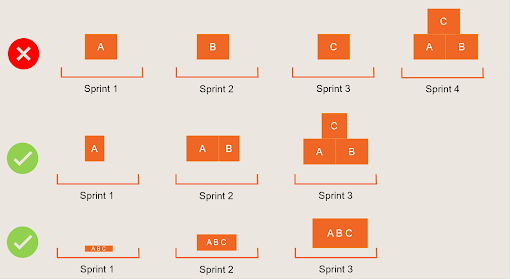BDB650
Scrum: Artifacts
Summary
Product Backlog
Sprint Backlog
Increment
Working Agreement*
Overview
Artifacts Overview
Scrum artifacts represent work or value
Provide transparency and foster communications
Access should be universal for the entire team
Artifacts Overview
Artifacts have commitments:
Product Backlog → Product Goal
Sprint Backlog → Sprint Goal
Increment → Definition of Done
Product Backlog
Definition
Ordered list of what is needed to create/improve the product
Single source of the work undertaken
Responsibility of the product owner
Feedback from the team is crucial
Periodically refined
User Stories
Backlog items should be written as user stories
Non-technical description of a feature
Represent functionality that will be valued by the users
Template:
“As a [persona], I [want to], [so that].”
User Stories
“As an instructor, I want to deliver be best imaginable classes, so that all my students will succeed.”
“As a sales manager, I want to see a real-time dashboard of sales performance, so that I can make data-driven decisions.”
User Stories
User stories should be kept small
They should always be completed within a sprint
Somestimes, large user stories are referred to as epics. Epics can be split into smaller user stories
No need to to cover every little detail
User Stories
“As a marketing analyst, I want to analyze the effectiveness of marketing campaigns using objective metrics, so that I can optimize future campaigns for better results.”
“As a customer retention specialist, I want to predict which customers are at risk of churning, so that I can implement targeted retention strategies”
Product Goal
Overview
Sets a target for the Scrum Team to plan against
It is a long-term objective
Part of the Product Backlog
The Product Backlog provides the means to achieve the Product Goal
Overview
Product Goals should be:
Specific: Have a clear defined scope
Measurable: A metric for evaluate its success
Time-bound: A deadline or set of deadlines
Examples
“We choose to go to the moon. We choose to go to the moon in this decade... ” JFK
“Lose/Gain 10 pounds of fat/muscle before next Summer.”
Examples
Develop and deploy a sales forecasting model within the next 3 months that predicts sales for the next quarter with at least 90% accuracy.
Build a web traffic analytics tool within 2 months that provides detailed insights into user behavior on the website using key metrics like bounce rate, session duration, and conversion rates for different traffic sources.
Sprint Backlog
Overview
Plan by and for the Developers
Snapshot of the work to be done in the Sprint
Updated and tracked throughout the Sprint
Elements
Composed of:
Sprint Goal → why
Selected Product Backlog items* → what
Actionable plan → how
Elements
Should have enough detail so that progress can be tracked on Daily Scrums
Items not finished might leak to future sprints...
...or get discarded
Acceptance Criteria
User stories are typically defined with acceptance criteria
Define measurable requirements that must be met for a user story to be considered complete
Each criteria should be written in a way that allows for validation
Serve as a shared agreement between the Product Owner, Developers, and Stakeholders
Sprint Goal
Overview
Single objective for the Sprint
Helps to focus efforts
Created during the Sprint Planning
Examples
Clean and preprocess the sales data from the last 6 months.
Develop a prototype for the customer churn prediction model.
Increment
Overview
Stepping stone towards the Product Goal
Sum of all the Product Backlog items completed during the current Sprint and all previous Sprints*
Multiple Increments may be created within a Sprint
Only counts what meets the Definition of Done
Increment

Definition of Done
Overview
Criteria that must be met for a user story to be considered done
Agreed upon by the team and prominently displayed
Serves as a guide and frequently include testing
Example
Met the acceptance criteria
Merged into the shared repository
Peer Reviewed
Tested on all intended platforms
Required documentation was completed
Deployed to production
Working Agreement*
Problems that can arise
TMs ghosting others for several days
TMs delivering at the very last minute
TMs "breaking" other TMs code
Less than cordial communications
Working Agreement
Set of guidelines created by the Team for the Team
Delineates expectations
Should be small, updated as needed, and establish consequences
Working Agreement
Things to include:
→ Preferred form of contact and overall availability
→ Meeting schedules
→ Scripting practices to be adopted
→ How to update datasets and scripts repository
→ What to do when a member misses a meeting